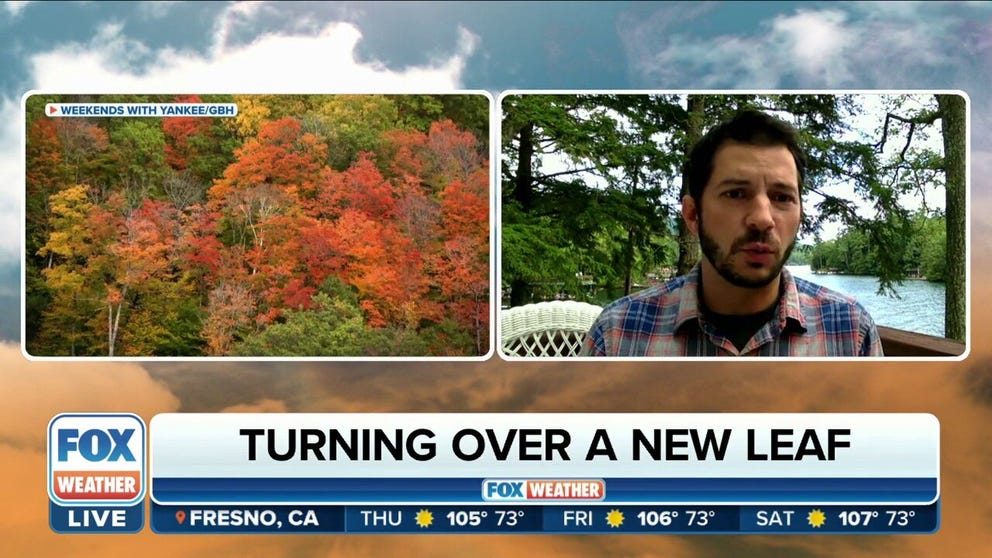What does a sizzling summer mean for autumn leaves?
Sightseers interested in witnessing some of the earliest changes in leaf colors are encouraged to visit Denali National Park & Preserve in late August. The protected lands encompass more than 6,000,000 acres and are home to the tallest mountain peak in North America.
How does weather impact fall foliage?
Foliage expert Jim Salge on where in the U.S. fall will show off its colors
The halfway point of summer is behind us, and in just a few weeks, signs of a new season will begin to emerge across the northern parts of the continent.
Alaska and northern Canada are the first regions where temperatures and daylight diminish rapidly, triggering the onset of autumnal changes in the landscape.
The annual fall foliage doesn’t truly reveal itself in the Lower 48 until later in September, reaching its peak in October or November, depending on the location.
Weather conditions before and after the change of season also influence the vibrancy of these sights.
Heat waves occurring in late summer and early fall can delay the relaxation of chlorophyll production in trees, keeping leaves greener for longer into the season.
In areas experiencing drought, the stress on trees can alter the timing of leaf shedding and lead to more muted colors.
WHAT DOES SIZZLING SUMMER MEAN FOR FALL FOLIAGE? HERE’S A PREVIEW
Warm summer transitions into warm fall
As summer wanes, forecasters expect temperature and precipitation patterns to align more closely with traditional La Niña influences.
NOAA forecasters are operating under what is known as a La Niña Watch, with a 70% chance that the global pattern will emerge over the fall and an 80% likelihood over the winter months.
Once the bona fide pattern is in place, it would result in a generally warmer and drier southern tier, with cooler and wetter conditions over the northern half of the country.
However, this pattern may not establish itself until well into winter, after trees have shed most of their leaves.
Before then, forecasters expect warmer and drier conditions to envelop much of the nation.
A NOAA climate outlook for September, October and November shows the highest chances of above-average temperatures in the Northeast, Southeast and Southwest.
Precipitation chances will be at or below normal for most of the country, but the Pacific Northwest and East Coast are most likely to see above-average rainfall.
Chances of high precipitation across the East are directly correlated to increased tropical activity in the Atlantic basin.
WHY IS THE PUMPKIN ASSOCIATED WITH FALL?
Drought is a worry for some
Increasing drought conditions from the West through the Rockies and into the mid-Atlantic have the potential to derail a memorable fall foliage season for some.
According to the latest U.S. Drought Monitor, 27% of the West and slightly more of the Southeast are officially experiencing drought conditions.
These dry conditions are affecting vast stretches of the Rockies, Appalachians, Smoky Mountains and Blue Ridge Mountains, where tourists tend to flock to witness autumnal changes.
Drought conditions are known to delay the onset of fall colors by weeks and increase the likelihood of leaves turning brown.

(FOX Weather)
The drought status is expected to continue, if not worsen, in areas of the Southwest and Rockies, while the eastern U.S. remains a wildcard.
Tropical moisture could reverse the trend, but impacts from a tropical cyclone are not guaranteed.
Sightseeers in the Northeast, Upper Midwest and Alaska could be in for a vibrant fall foliage season.
All these regions have experienced normal or above-normal precipitation patterns through the first half of the year, and additional rainfall is expected during the later summer and fall months.
The Last Frontier is typically one of the first regions where sightseers flock to witness the changing of the leaves.
Denali National Park & Preserve encompasses over 6,000,000 acres and is a popular destination in the state.


